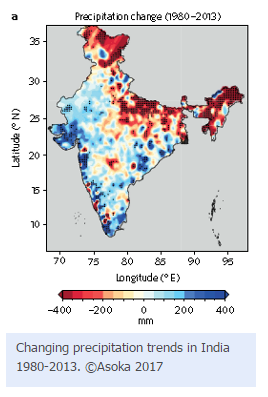Changing Rainfall Patterns Linked to Water Security in India
Published on by Vishakha Rajput, Previous COO The Water Network at AquaSPE AG in Academic
International Institute for Applied System Analysis (IIASA) writes, Changes in precipitation, which are linked to the warming of the Indian Ocean, are the main reason for recent changes in groundwater storage in India.
 Changing rainfall is the key factor driving changes in groundwater storage in India, according to a new study led by the Indian Institute of Technology (IIT) Gandhinagar published in the journal Nature Geoscience.
Changing rainfall is the key factor driving changes in groundwater storage in India, according to a new study led by the Indian Institute of Technology (IIT) Gandhinagar published in the journal Nature Geoscience.
The study shows that changing monsoon patterns—which are tied to higher temperatures in the Indian Ocean—are an even greater driver of change in groundwater storage than the pumping of groundwater for agriculture.
Agriculture in India relies heavily on groundwater for irrigation, particularly in the dry northern regions where precipitation is scarce.
Groundwater withdrawals in the country have increased over tenfold since the 1950’s, from 10-20 cubic kilometers per year in 1950, to 240-260 cubic kilometers per year in 2009.
And satellite measurements have shown major declines in groundwater storage in some parts of the country, particularly in northern India.
“Groundwater plays a vital role in food and water security in India. Sustainable use of groundwater resources for irrigation is the key for future food grain production,” says study leader Vimal Mishra, of the IIT Gandhinagar. “And with a fast-growing population, managing groundwater sustainably is going become even more important.
The linkage between monsoon rainfall and groundwater can suggest ways to enhance groundwater recharge in India and especially in the regions where rainfall has been declining, such as the Indo-Gangetic Plain.”
“This study adds another dimension to the existing water management framework. We need to consider not just the withdrawals, but also the deposits in the system,” says Yoshihide Wada, a study coauthor and the deputy director of the Water program at the International Institute for Applied Systems Analysis (IIASA) in Austria.
The issue of groundwater depletion has been a topic of much discussion in India, but most planning has focused on pumping, or the demand side, rather than the deposit side. By looking at water levels in wells around the country, the researchers could track groundwater replenishment following the monsoons. They found that in fact, variability in the monsoons is the key factor driving the changing groundwater storage levels across the country, even as withdrawals increase.
In addition, the researchers found many other interesting details about Indian water sector-
Read the entire article here: http://www.iiasa.ac.at/web/home/about/news/170109-groundwater.html
Media
Taxonomy
- Drainage
- Groundwater
- Water Balances
- Rain Water Management
- Ground Engineering
- India
3 Comments
-
Constant river pollution leads to a reduction in infiltration and the replenishment of underground reservoirs. It is necessary to deepen and clean the bottom of the rivers and retain water in them in the summer.
Постоянное засорение рек приводит к сокращению инфильтрации и пополнению подземных резервуаров. Необходимо углублять и очищать дно рек и сохранять в них воду в летнее время.
-
While no one denies the link between climate teleconnections and precipitation, saying that this is the main reason can have unintended misinterpretation, and a lack of focus on improving watershed management to retain water, regulate streamflow, promote groundwater recharge via infiltration and so on.
-
We need good water management system to maintain the water table at the desired root zone level for the crops either from excessive precipitation or runoff water from flood or both. This also need effective monitoring system for the same.